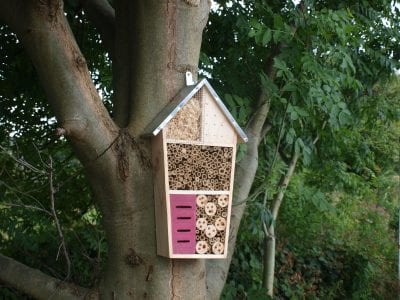A Guide to Insect Hotels in the Garden

A Guide to Insect Hotels in the Garden
Our Insect hotels range features six key pieces in various sizes and colours. The Tower was a Gift of the Year Finalist in 2017 and now one of our best -selling lines.
Many gardeners often think about taking care of birds that visit the garden but not an awful lot of thought is given to the insects that also inhabit the garden. Deco-Pak has researched the average garden and subsequently introduced several innovative lines to the Garden Bazaar Range.
A key visitor to the British garden is the humble bumble bee which we should all consider giving some support to when the busy Summer comes to an end. Although most bees have vacated the garden now, ivy bees may still be out there looking for the late-flowering English ivy collecting whatever nectar is available to them.
From late September / October, most bees will be looking for shelter to get them through the Winter which is where Insect Hotels become the garden centrepiece. Key components to the hotels are logs, bark, bamboo and fir cones in various shapes and sizes to allow easy entry for all. The hotel is also a great spot for garden spiders.
Benefits of Insect Hotels
Encouraging biodiversity is good for the ecological balance in the garden. Since our gardens are home to a vast range of living creatures, in some cases over 2,000 different species of invertebrates it is important to try and conserve this wildlife. Giving these Insects a home can help your garden to prosper and help the conservation of vital wildlife. Gardens can flourish as these insects’ hotels will house pollinating bees, attract ladybirds and lacewings, both of which are natural aphid & greenfly (garden pests) predators.
Where to place your Insect Hotel
Solitary bees like to be warm so having the hotel on a south-facing wall is another consideration to aid their inhabitancy. Therefore, the best position for insect hotels is in sunlight or light shade, preferably 1.5m off the ground.
| Bugs & Bees | Where they go | When to expect | In the Hotel | Garden Benefits |
| Solitary Bees | Bamboo Tubes | Spring / Summer | Laying eggs | Pollinating flowers |
| Ladybirds | wood shavings | Winter | Hibernate | Eat aphids (garden pests) |
| Lacewings | Columns and tubes | Winter | Hide & Hibernate | Eat aphids & greenflies (garden pests) |
| Other Invertebrates | Acorns and other crevices | All year round | Shelter and Hibernate | Wildlife conservation |
Some interesting facts to make you think
• 8 out of 10 wildflowers could disappear without insect pollination
• Solitary bees make up the largest percentage of the bee population, with 90% of bees being in the solitary category
• Over its lifetime, a ladybird may consume as many as 5,000 aphids
To view our full range of Insect Hotels click here!
